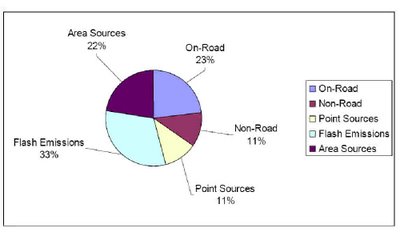Pollution Begets Pollution
Oil and gas developments already release more ozone forming compounds into the air of the Denver metro area than any other source of pollution. Referred to as flash emissions, 1/3 of all ozone forming compounds released by human sources comes from the oil and gas industry (see the chart below, which was prepared by the state of Colorado).
 Yet a recent analysis done by the state reports that air pollution in the Denver area actually enhances the reactivity of ozone forming compounds released from oil and gas developments. What this means is that emissions from oil and gas developments, which are already high, are turning to ozone sooner as a result of Denver's existing air pollution. This report once again squarely contradicts claims by the oil and gas industry that its emissions aren't contributing to unhealthy ozone pollution.
Yet a recent analysis done by the state reports that air pollution in the Denver area actually enhances the reactivity of ozone forming compounds released from oil and gas developments. What this means is that emissions from oil and gas developments, which are already high, are turning to ozone sooner as a result of Denver's existing air pollution. This report once again squarely contradicts claims by the oil and gas industry that its emissions aren't contributing to unhealthy ozone pollution.The analysis, which is summarized here, reports that alkanes, ethane, and methane, which comprise over 80% of all ozone forming compounds released by the oil and gas industry in the Denver metro area, will react with sunlight to form ozone much sooner in polluted atmospheres. The analysis reports that alkanes will react to form ozone in less than a day in polluted atmospheres. In nonpolluted atmospheres, these compounds won't turn to ozone for weeks.
Although this report underscores the fact that all ozone forming compounds are contributing to unhealthy smog, it definitely points to oil and gas developments north of Denver as the most significant source of smog pollution. The state is proposing to impose more stringent ozone controls on the oil and gas industry in the Denver area and clearly there is every reason to do so.

0 Comments:
Post a Comment
<< Home